Almost all homes and office buildings in America today are equipped with air conditioning units. With global temperatures continuing to rise, the presence of AC in people’s daily lives will become even more prevalent.
While air conditioning units provide cooling relief, they can also be potentially damaging to human health. The cooling coils within AC units are breeding grounds for microbes, which can cause adverse health effects in humans. Beyond potential impacts on health, the microbial loading on cooling coils in AC units can also lower their efficiency.
So, what factors impact the growth of microbes on air conditioning cooling coils? New research from at the Peccia Lab at Yale University may have answers. The study, which investigated building and environmental factors that influence coil bacteria growth, focused on larger commercial AC units in large buildings in Connecticut and Sacramento. The cities have diametrically opposed climates, allowing for a wider range of latent cooling loads, the amount of energy needed to dehumidify the air. The study found that the loading of bacteria and fungi on cooling coils varied widely between units. Fungal loading increased with coil moisture and coil temperature and was impacted by geographic location and coil location within the unit. Bacterial loading and fungal loading were both impacted by the efficiency of the filters of AC units.
These results offer a better understanding of how to operate more efficient AC units and to reduce potential microbe emissions. These improvements would better human health and help save energy.

